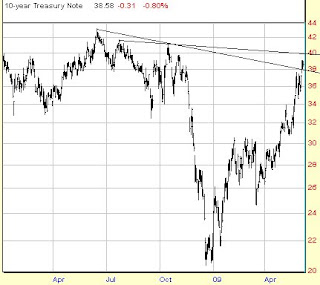
Friday, June 12, 2009
Thursday, June 11, 2009
Video Update 米国株式市況 6月11日09年
今日は債券、金利、為替、原油、金、コモデイテー、バークレーズ・キャピタル債券指数、30年物米国債入札、(CVX)シェブロン、(SLB)シュランバージエイ、(HAL)ハリバートン、(AKS)エイ・ケイ・スチール、(NUE)ニューコア、その他。
経済データでは:失業保険申請件数、4週移動平均、失業保険継続受給者数、小売売上高、
企業在庫、企業在庫。
Wednesday, June 10, 2009
Video Update 米国株式市況 6月10日09年
今日は債券、金利、為替、原油、金、コモデイテー、ロシア外貨準備金、(HD)ホーム・デポ、10年物米国債入札、(DJUA)ダウ公共株指数、その他。
経済データでは:米貿易統計、ベイジュ・ブック。
Tuesday, June 9, 2009
Video Update 米国株式市況 6月8日09年
今日はTARP資金返済、TARP監督機関、(JPM),ジェイ・ピー・モルガン、(GS)ゴールドマン。サックス、(AXP)アメリカン・エクスプレス、(USB)ユー・エス・バンクコープ、(COF)キャピタル・ワン、(BK)バンク・オブ・ニューヨーク・メロン、(STT)ステート・ストリート・バンク、(BBT)ビ・ビ・アンド・テイ、(KEY)キーコープ、(MS)モルガン・スタンレー、(NTRS)ノーザン・トラスト、(TXN)テキサス・インストラメンツ、(MCHP)マイクロチップ・テクノロジー、など。
経済データでは:卸売在庫
COP ストレス・テストの評価レポート発表
今日はTARP資金返済が話題の注目点でしたが、それとは別にCongressional Oversight Panel(議会が設けたTARPの監査機関)がストレス・テストに関する評価レポートを発表しました。今回のストレス・テストは高く評価していますが、いくつかの問題点を残していると指摘。 まず、最悪のシナリオに使われた失業率は年平均8.9%でしたが、実際には5月で9.4%。このトレンドが通けば想定を上回り、再テストが必要。また、銀行が大量な toxic assets(不良資産)を抱える限り、再テストの必要性は残るなどと書かれています。
Congressional Oversight Panel Releases Oversight Report on Stress Tests
Panel finds that stress test models were reasonable, but serious concerns remain
WASHINGTON, D.C.—On June 8, 2009, the Congressional Oversight Panel released its June Oversight Report, “Stress Testing and Shoring Up Bank Capital,” which examines the recent stress tests conducted on America’s 19 largest bank holding companies (BHCs).
In early February, Treasury and the Federal Reserve Board announced an effort to conduct comprehensive and simultaneous reviews of the nation’s largest BHCs—those with more than $100 billion in assets—to determine their ability to remain well capitalized if the recession leads to deeper than expected losses. The effort, called the Supervisory Capital Assessment Program (SCAP), is referred to more informally as the stress tests. BHCs found to be in need of an additional capital buffer were given six months to raise the necessary capital. By ensuring that America’s largest banks could weather the financial storm, stress testing aimed to restore market confidence and help put the economy back on track.
The Panel’s report examines how effectively Treasury and the Federal Reserve conducted the stress tests, specifically reviewing the government’s economic assumptions, their methods of calculating bank capitalization, their release of information to the public, and whether the stress tests should be repeated in the future. To help make these assessments of the stress tests, the panel engaged two internationally renowned experts in risk analysis, University of California at Berkeley Professors Eric Talley and Johan Walden, to review the stress test methodology.
The Panel finds that, on the whole, the stress tests were based on a solidly designed working model. However, serious concerns remain, and the Panel offers several recommendations for consideration moving forward:
The unemployment rate climbed to 9.4% in May, bringing the average unemployment rate for 2009 to 8.5%. If the monthly rate continues to increase, the 2009 average may exceed the 8.9% assumed under the more adverse scenario, suggesting that the stress tests should be repeated if that occurs.
Stress testing should also be repeated so long as banks continue to hold large amounts of toxic assets on their books.
Between formal tests conducted by the regulators, banks should be required to run internal stress tests and should share the results with regulators.
Regulators should have the ability to use stress tests in the future when they believe that doing so would help to promote a healthy banking system.
This report strives to provide Treasury and the Congress with the necessary context and comparative analysis to understand the possible policy choices. The Panel hopes to assist Congress and Treasury officials in weighing the available options as the nation grapples with the worst financial crisis it has faced since the Great Depression.
The full report can be found at http://cop.senate.gov/documents/cop-060909-report.pdf.
The Congressional Oversight Panel was created to oversee the expenditure of the Troubled Asset Relief Program (TARP) funds authorized by Congress in the Emergency Economic Stabilization Act of 2008 (EESA) and to provide recommendations on regulatory reform.
The Panel members are: Congressman Jeb Hensarling (R-TX), Richard H. Neiman, Superintendent of Banks for the State of New York, Damon Silvers, Associate General Counsel of the AFL-CIO, former U.S. Senator John E. Sununu (R-NH) and Elizabeth Warren, Leo Gottlieb Professor of Law at Harvard Law School.
June 9, 2009
For Immediate Release
Source: Congressional Oversight Panel
COPのヘッド、エリザベス ウオーレン氏のCNBCでのインタビユー。
米財務省 TARP資金返済のコメント
TG-162
Treasury Announces $68 Billion in Expected CPP Repayments
WASHINGTON ・The U.S. Department of the Treasury announced today that 10 of the largest U.S. financial institutions participating in the Capital Purchase Program (CPP) have met the requirements for repayment established by the primary federal banking supervisors. Following consultation with the primary banking supervisor of each institution, Treasury has notified the institutions that they are now eligible to complete the repayment process. If these firms choose to do so, Treasury will receive $68 billion in repayment proceeds.
Combined with repayments received to date from other institutions, Treasury will have received approximately $70 billion in repayments from CPP participants. More than 600 banks across the country have participated in the CPP, representing $199 billion in investments.
"These repayments are an encouraging sign of financial repair, but we still have work to do," said Secretary Tim Geithner.
These repayments follow a period in which many banks have successfully raised equity capital from private investors. Also, for the first time in many months, these banks have issued long-term debt that is not guaranteed by the government.
Under the CPP investment agreements, firms that repay their preferred stock have the right to repurchase the warrants Treasury holds in their firms at fair market value. In addition to Treasury's potential income from sale of the warrants, these 10 institutions have already paid dividends on the preferred stock totaling approximately $1.8 billion over the last seven months. Dividend payments received for all CPP participants are approximately $4.5 billion to date.
Under the Emergency Economic Stabilization Act, proceeds from repayment will be applied to Treasury's general account. These repayments help to reduce Treasury's borrowing and national debt. The repayments also increase Treasury's cushion to respond to any future financial instability that might otherwise jeopardize economic recovery.
Source: U.S. Treasury Department
Monday, June 8, 2009
Video Update 米国株式市況 6月8日09年
今日は 為替、金利、コモデイテー、原油、金、債券、TARP資金返済、医療保険制度改革、(MCD)マックドナルド,その他。
経済データでは:OECD景気先行指数




























